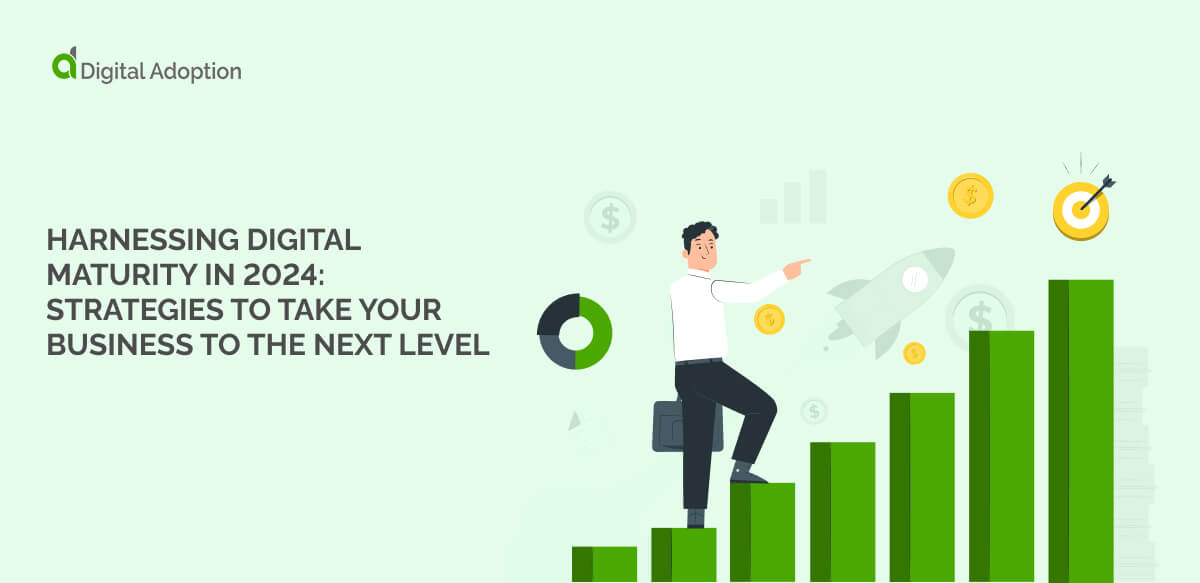The assessment of digital maturity should be a core element of any digital transformation roadmap. Digital maturity describes various ways of measuring a company’s digital capabilities compared to similar companies in their industry.
When a company is digitally mature, it can reap the benefits. Comparing themselves against the industry averages, they can see how the benefits of efficiency, reliability, and availability create more value for a company. Digital maturity benchmarks can form a useful tool at the planning, implementation, and review stages of a transformation journey, providing a transparent data set for analysis.
Companies undertake digital transformation projects to improve their business processes using technology. This is a broader process than digital maturity. Digital transformation involves various activities, such as adopting new digital tools and processes, rethinking business and operating models, and developing new capabilities and competencies.
Digital transformation often requires organizations to fundamentally rethink and redesign their processes, operations, and business models to fully leverage the potential of digital technologies. Digital maturity is a gauge of an organization’s growth in digital adoption and its success on the path to digital transformation. It requires continual adaptation and improvement, enabling businesses to capitalize on technology resources for long-term competitive advantage in today’s evolving market.
A clear understanding of digital maturity will be more important than ever. Remember that a 2022 Gartner survey found that up to 94% of EMEA organizations struggle with developing a vision for digital change, often due to competing ideas of success within the business. As this article will show, digital maturity models, are an effective tool for developing a company vision.
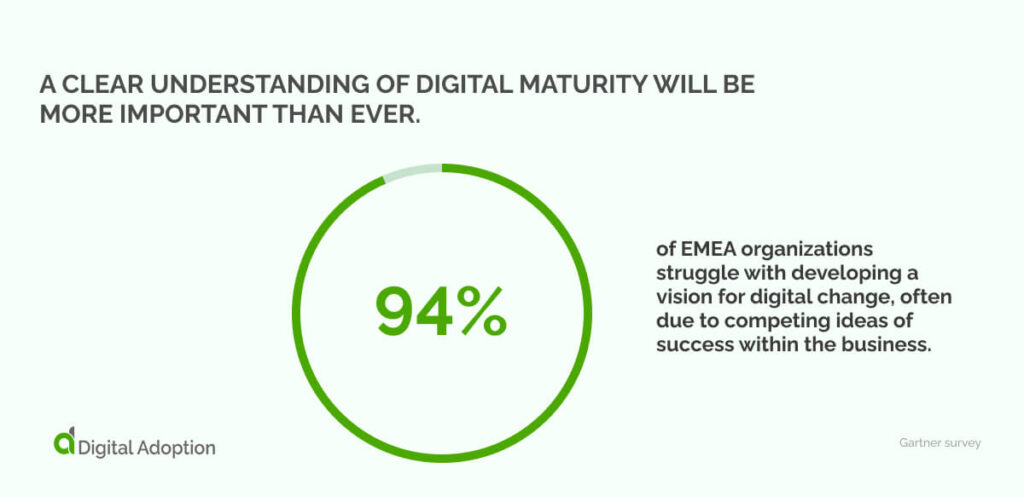
Just as a complete digital transformation is hard to achieve, digital maturity is hard to measure systematically. But change managers are always grateful for digital maturity models for demonstrating successful outcomes to business leaders at every level.
The article will start by explaining the concept of digital maturity, its relationship with digital transformation, and the benefits it brings. It will then explain some widely-used methods of measuring digital maturity and how to choose an appropriate model for any given company.
- What is digital maturity?
- How do digital maturity and digital transformation intersect?
- Why achieving digital maturity is crucial for prospective business success
- The benefits of digital maturity models (DMM)
- Digital maturity model examples
- Grossman’s 4 Stages of Digital Maturity
- How Deloitte’s model powers digital transformation in three stages
- Types of Digital Maturity Models
- The Six Top digital maturity challenges
- The role of digital adoption in achieving digital maturity
- Why mature digital capabilities are key for value creation
- Creating a digitally mature organization and beyond
What is digital maturity?
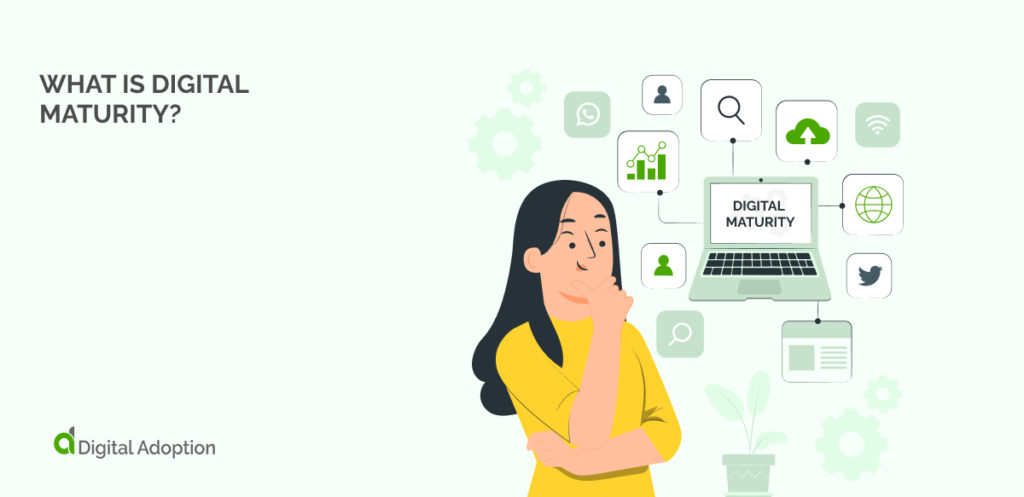
Digital maturity is a term used to describe an organization’s progress in using digital technology to enhance and transform its operations, products, and services. It encompasses a range of factors, such as the extent to which an organization has embraced digital tools and processes, the effectiveness of its digital strategy and execution, and the extent to which it can adapt and respond to the changing digital landscape.
The meaning of digital maturity can vary significantly from one organization to another since the prime digital capabilities of each business will be very different. Nonetheless, across companies, approaches to digital maturity are often used to benchmark, assess, and compare the success of the business’s digital technology.
Digital maturity is just one element of organizational maturity, which can include measuring features such as HR, change management, and finance.
How do digital maturity and digital transformation intersect?
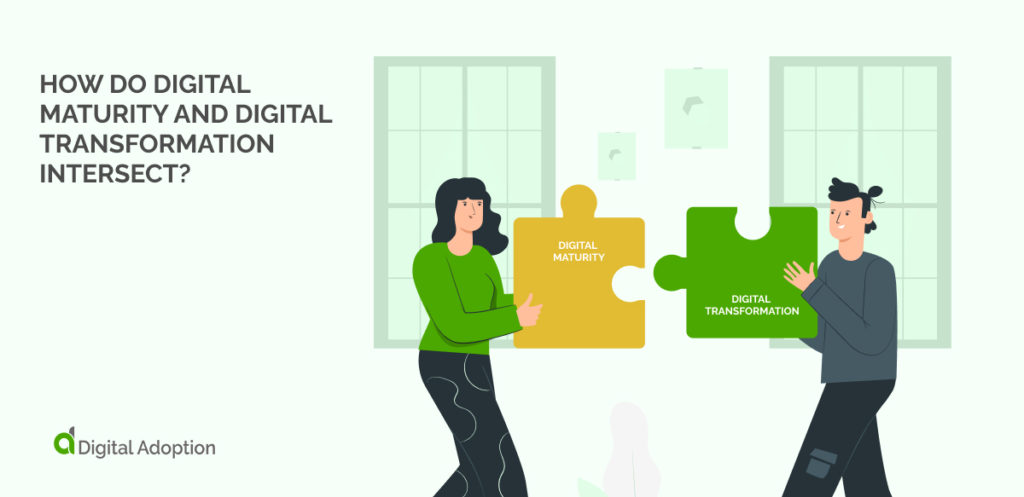
Digital transformation and digital maturity are related but not the same thing. Put simply, digital maturity is a great way to measure success in a digital transformation, but it does not indicate the methods of achieving digital transformation.
Digital maturity measures an organization’s progress in achieving its digital goals. It measures success across the organization, from technology usage to data literacy and innovation. To understand digital maturity, organizations must assess both the current state and future potential for digital transformation. This assessment could include factors such as developing new technologies and processes, optimization of customer experience, and operational efficiency.
Digital maturity can be a valuable tool for measuring success in digital transformation. It provides insights into how far the organization has come and areas where it can improve. Organizations should use it to identify gaps and opportunities for further digital transformation to focus their efforts and resources on the areas that will yield the most benefit.
As part of a digital transformation project, businesses may use the concept of digital maturity to measure their success in achieving the goals of a digital transformation. As digital maturity measures an organization’s adoption of new digital methods, it provides insight into the level of transformation the organization has reached.
Why achieving digital maturity is crucial for prospective business success

Digital maturity is crucial to success in the digital age. As the lives of every customer become more digitized, businesses can no longer afford to be behind the curve when it comes to leveraging new tools and technologies. Digital maturity helps organizations stay ahead of their competition by giving them an understanding of their current capabilities and allowing them to identify areas for improvement.
Digital maturity helps organizations create crucial competitive advantages by allowing them to identify and capitalize on new opportunities faster than their competitors. Businesses can take advantage of emerging trends before their competitors do by having a deep understanding of digital tools and technologies.
Digital maturity can foster a culture of innovation within an organization, as employees can use digital tools and processes to test new ideas and explore new opportunities. In a digitally mature organization, employees are better prepared to test and adapt new technologies as they become available.
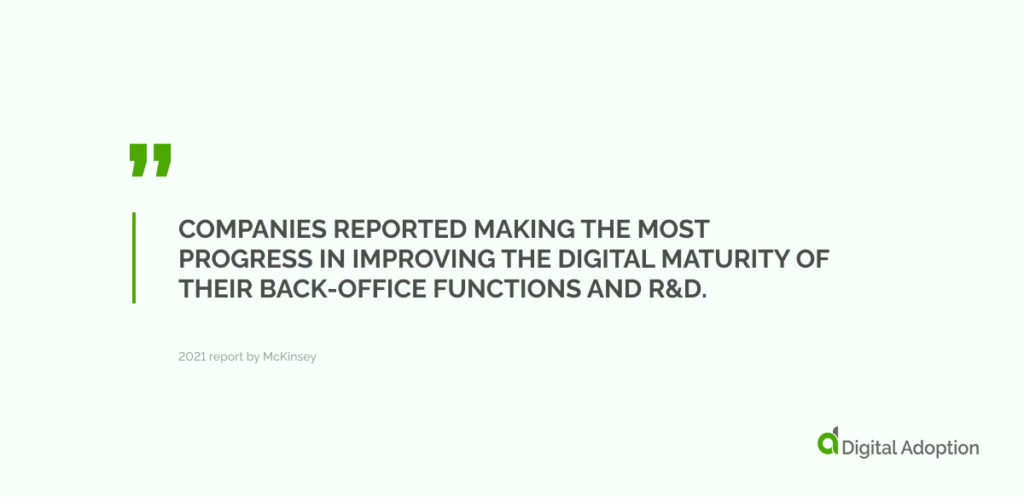
Although digital maturity sometimes comes from front-end changes, a 2021 report by McKinsey showed that “companies reported making the most progress in improving the digital maturity of their back-office functions and R&D.” As a result, it’s important to find a digital maturity model that can take into consideration the organization’s ability to take on new technology in every aspect of its work.
The benefits of digital maturity models (DMM)

The concept of digital maturity is simple. But to create consistent reporting standards, it’s very useful to use an established digital maturity model.
Companies use digital maturity models to assess and measure their progress in using digital technology to enhance and transform their operations, products, and services. Digital maturity models typically consist of criteria or benchmarks that an organization can use to assess its level of digital maturity.
Here are four ways that a digital maturity model can support business growth:
- Better Product Quality
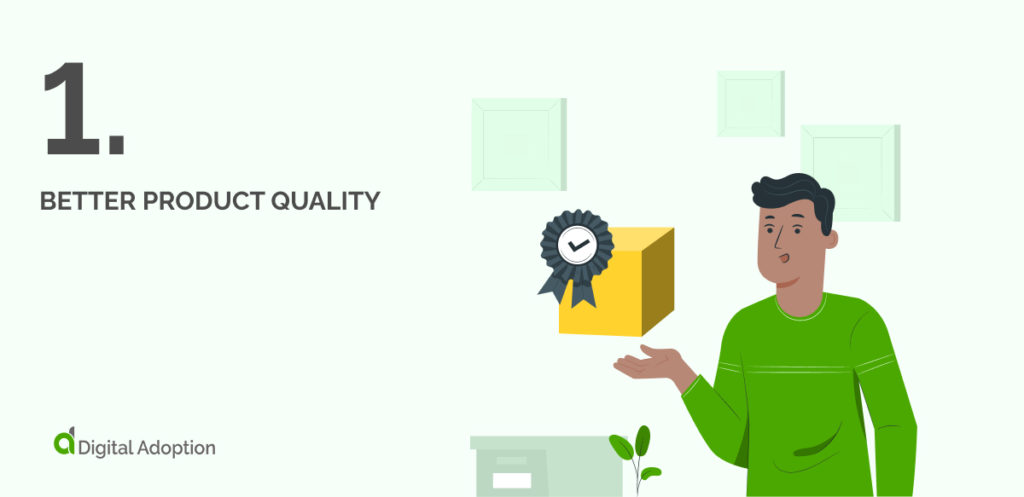
A digital maturity model can help product teams to identify the best ways to use technology and processes to improve product quality.
Digital maturity can support better product quality through improved design and development processes, enhanced testing and quality assurance, greater collaboration and communication, and increased visibility and transparency. Digital tools and processes can streamline product design, automate testing, facilitate collaboration, and provide greater visibility into the development process. This can lead to more efficient and accurate design, more consistent and reliable product quality, and improved coordination and decision-making.
- Improved Efficiency
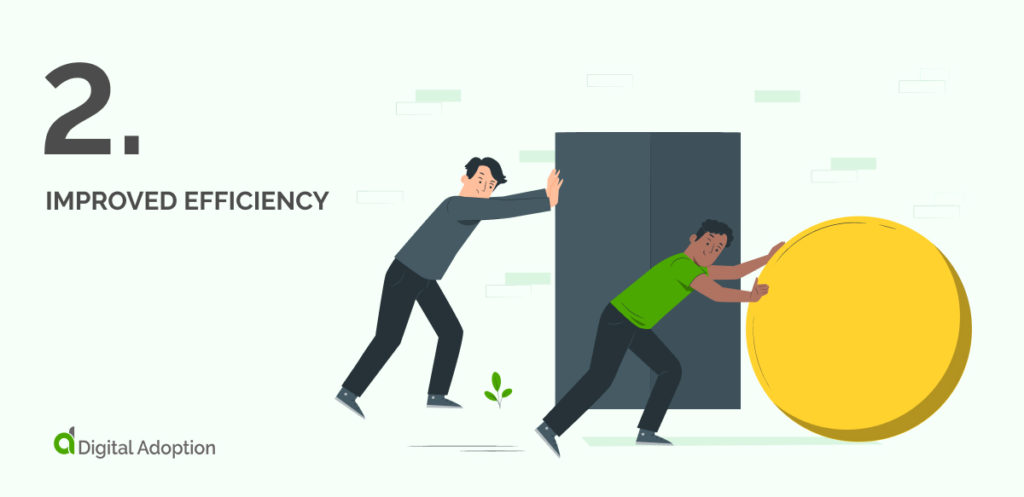
Digital maturity models can help organizations identify the best ways to use digital technologies and processes to improve efficiency across the organization. By assessing their current level of digital maturity, businesses can identify areas where they need to invest in new tools and practices. This could include using machine learning or analytics to automate processes, integrating systems for end-to-end visibility, or implementing cloud-based solutions for faster product development.
Digital tools are most successful when employees use them effectively. It’s not enough for staff to be competent and knowledgeable. Organizations achieve the highest efficiency from their digital implementations when everyone has instinctive confidence with the tools they’ve been given.
- Employee Upskilling
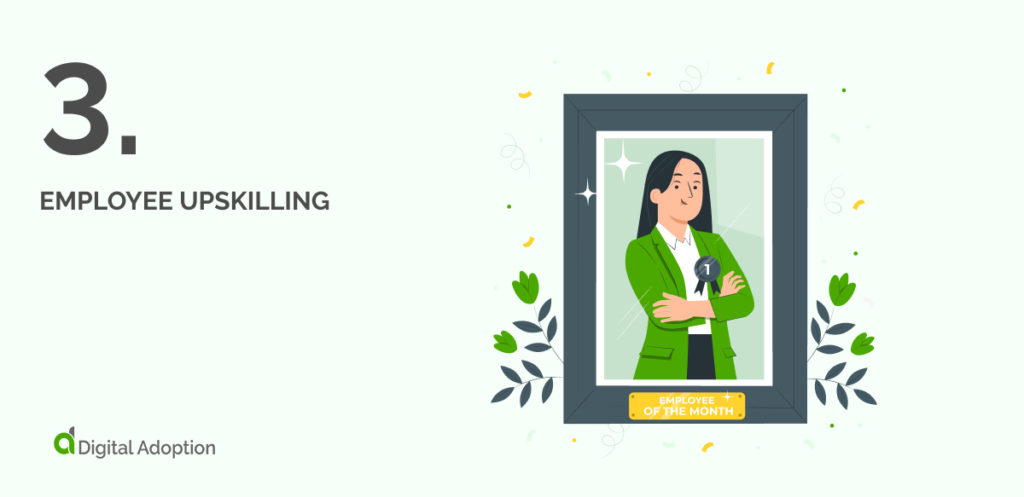
Digital maturity models can help organizations identify the specific digital skills and knowledge their employees need to succeed in their roles. Organizations can use targeted training methods to help employees effectively use digital tools and processes by understanding these gaps. This can include investing in employee development programs such as training courses, certification programs, or on-the-job learning opportunities.
By investing in upskilling their employees, businesses can not only help their employees become more proficient in using digital tools and processes, but they can also ensure that they have the skills and knowledge needed to take full advantage of emerging technologies and stay competitive in a rapidly changing market. This can lead to improved efficiency and productivity, enhanced customer experiences, and greater innovation within the organization.
- Enhanced Customer Experience
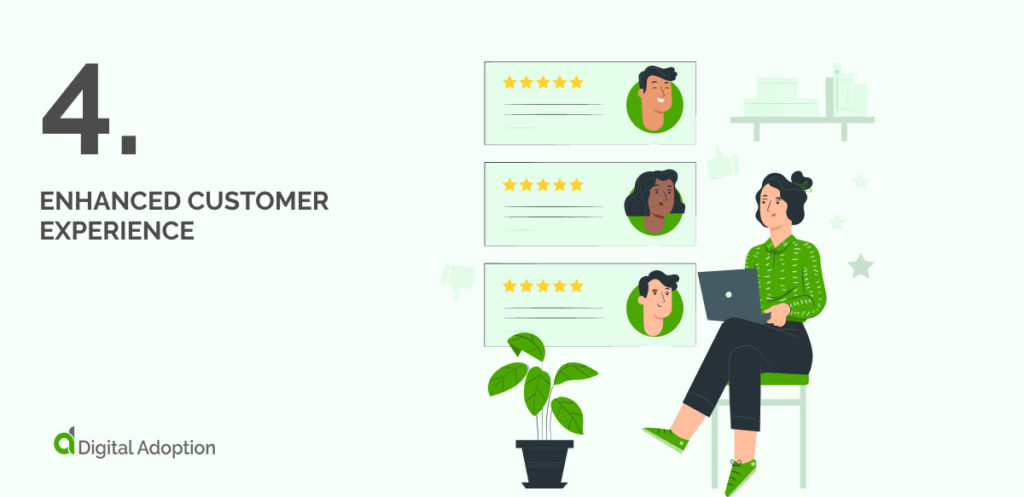
Digital maturity models can help organizations identify opportunities to use digital technologies to enhance the customer experience. A digitally mature organization is better equipped to leverage data-driven insights and digital tools to create personalized customer experiences across multiple channels, such as websites, mobile apps, social media, and in-store interactions.
Organizations can use digital technologies to deliver more engaging and personalized customer experiences by investing in digital maturity and upskilling their staff. This could include providing personalized product recommendations, creating targeted marketing campaigns, or optimizing customer service processes. By doing so, organizations can create a truly differentiated customer experience that sets them apart from the competition and helps to build customer loyalty.
Digital maturity model examples
Off-the-shelf models are widely available and can be quickly and easily adopted by organizations, helping them to understand their current level of digital maturity and identify areas for improvement. Digital maturity models give a structured approach for evaluating and benchmarking digital capabilities and allow for easy comparison with peers and industry standards. Some examples of off-the-shelf models include Deloitte’s Digital Maturity Model, BCG’s Digital Acceleration Index, and Google’s Digital Maturity Benchmark.
Deloitte’s Maturity Model
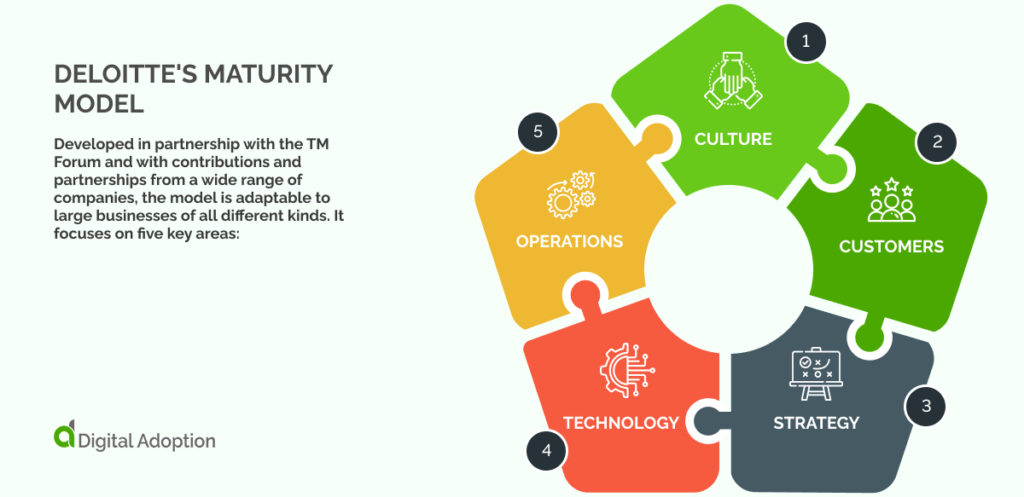
Deloitte’s Digital Maturity Model is a pioneering tool for assessing an organization’s level of digital maturity. Developed in partnership with the TM Forum and with contributions and partnerships from a wide range of companies, the model is adaptable to large businesses of all different kinds. It focuses on five key areas: culture, customers, strategy, technology, and operations. Within these areas, many specific criteria help to effectively evaluate an organization’s digital maturity.
However, it is important to note that the Digital Maturity Model is not a complete digital transformation framework. It is designed to evaluate an organization’s digital maturity at a specific time rather than serving as a roadmap for digital transformation. While it can be a useful tool for understanding an organization’s current level of digital maturity, it is not a comprehensive guide to implementing a successful digital transformation.
BCG’s Digital Acceleration Index
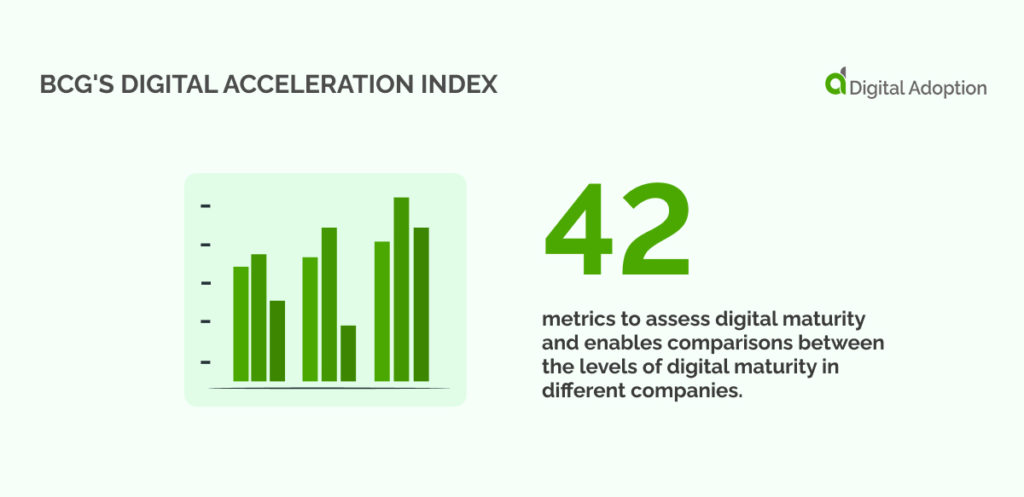
The Boston Consulting Group (BCG) produces an annual digital transformation survey called the Digital Acceleration Index (DAI). The DAI uses 42 metrics to assess digital maturity and enables comparisons between the levels of digital maturity in different companies.
BCG advises that organizations can use the DAI in two ways: to benchmark their capabilities at the planning stage of a digital transformation project and assess the other strengths in their current business model.
The DAI helps organizations focus their attention on the areas where they can make the best progress toward full digital maturity. It has been used successfully across various industries, including energy, aerospace, insurance, and mining. In its 2021 report, covering more than 2,000 companies, BCG demonstrated the resilience of digitally mature companies in an unpredictable world. They referred to the most digitally mature organizations as “bionic companies,” which can harness disruptive technology trends alongside their traditional operations.
The BCG’s 2021 report also showed that digital maturity drives business growth and highlighted the specific technologies that companies use to deliver significant benefits. By using the DAI, organizations can better understand their digital maturity and identify opportunities for improvement.
Benchmarking with Google and the BCG
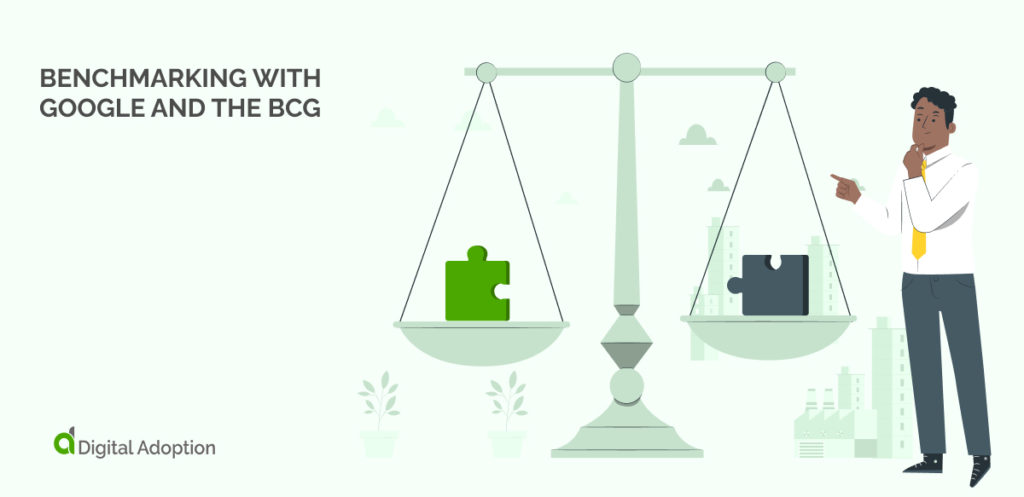
Google works with the Boston Consulting Group (BCG) to produce the Digital Maturity Benchmark tool, designed to help businesses understand the digital maturity of their marketing processes. The tool uses BCG’s data-driven insights to evaluate a business’s digital performance in five key areas:
- Analytics and measurement
- Assets and ads
- Audience
- Access
- Automation
By using the Digital Maturity Benchmark tool, businesses can better understand their current digital performance and identify areas where they need to improve. The tool categorizes digital processes into one of four maturity stages, helping businesses understand their progress and plan their next steps. This can be a valuable resource for businesses looking to optimize their marketing efforts and stay competitive in a rapidly changing digital landscape.
The four stages of maturity for the Digital Maturity Benchmark tool are as follows:
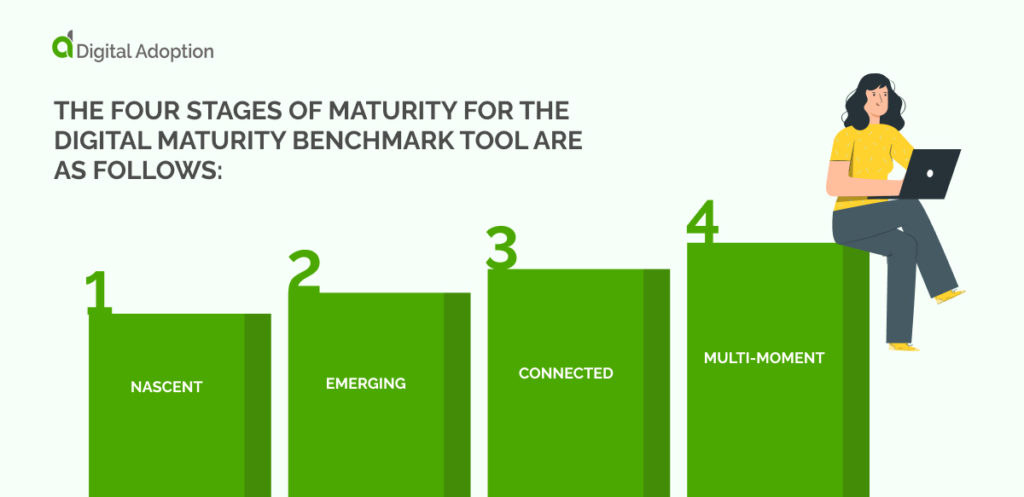
- Nascent
At the “nascent” level of digital maturity, marketing campaigns rely heavily on external data and direct buys, with limited links to sales. This means that campaigns may not be fully integrated with the rest of the organization’s sales and marketing efforts and may not be optimized for maximum effectiveness.
At this stage, the organization may miss out on the benefits of more advanced digital marketing techniques, such as targeting specific customer segments, using data analytics to optimize campaign performance, and integrating campaigns with other marketing channels.
- Emerging
At the “emerging” level of digital maturity, marketing campaigns may begin to use some owned data and automated buying, focusing on optimizing and testing single channels. This represents an improvement over the “nascent” level, as the organization is starting to use more advanced digital marketing techniques and integrate them with other marketing efforts.
However, the organization may still be limited in its use of data and technology. It may not be leveraging the full potential of digital marketing to drive sales and customer engagement.
- Connected
Marketing campaigns are fully integrated and activated across channels at the “connected” level of digital maturity. There is a clear link between the campaigns and key performance indicators such as return on investment (ROI) or sales proxies. This represents a significant improvement over the “emerging” level, as the organization is effectively using data and technology to drive business results and optimize the performance of its marketing efforts.
At this stage, the organization is likely to have developed a more sophisticated understanding of its customers. It can use data analytics and automation to deliver targeted, personalized marketing experiences. The organization may also use a wider range of marketing channels and tactics, such as social media, email, and mobile marketing, to reach and engage with customers.
- Multi-Moment
At the “multi-moment” level of digital maturity, marketing campaigns are dynamically executed across multiple channels, focusing on optimizing individual customer outcomes and transactions. This represents the highest level of digital maturity, as the organization can use data and technology to deliver highly personalized and effective marketing experiences that drive business results.
Grossman’s 4 Stages of Digital Maturity
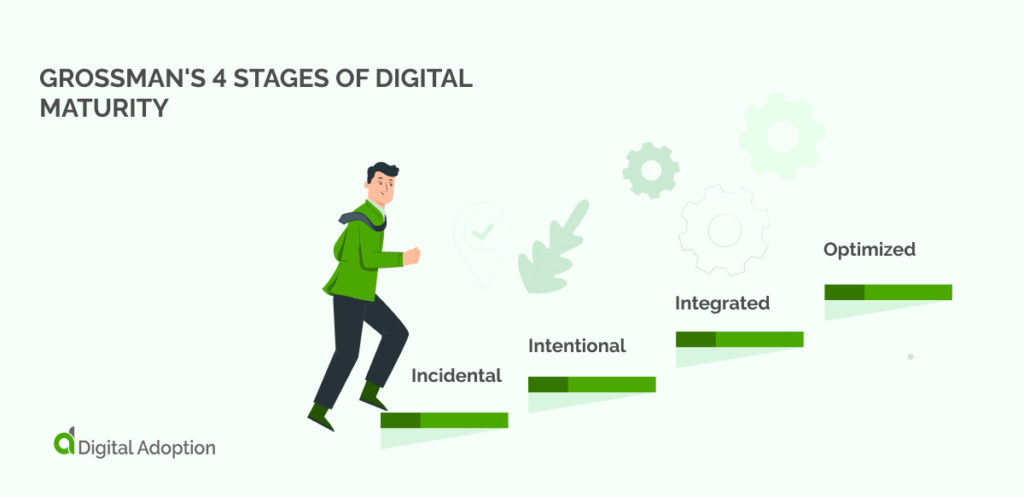
A wider view of the businesses can be very useful for making plans and measuring successes for digital transformations. Outside observers of many digitally mature organizations have some valuable insights.
In this section, we will explore insights from Justin Grossman. In a Forbes article, Grossman suggested that there were four primary stages to digital maturity: starting with the stage where digital transformation makes an incidental impact, through to the stage where organizations have an optimized use of technology.
Grossman was writing as an outside observer on digital projects, so his thoughts can be a useful way to help less digitally mature organizations get themselves into a better place.
Incidental
At this stage, companies may have some digital transformation activities in place but lack coordination, strategy, and a holistic approach. These companies also tend to have problems with data silos, and the impact of their digital initiatives is almost accidental.
Intentional
Companies at this stage are more purposeful and have a clear sense of design and direction for their digital projects. Their broad capabilities are developing appropriately, but challenges such as disconnection between different departments and lack of collaboration between internal business leaders still exist.
Integrated
Companies in this stage have successfully applied cutting-edge technology and have done so with a clear and integrated plan. The plans have been embedded for a while and are now starting to demonstrate the fruits of using digital transformation to power growth.
Optimized
At this stage, the company is a leading digital transformation organization and truly benefits from digital solutions. They are rolling out standard solutions and committing to implementing ongoing technological change.
How Deloitte’s model powers digital transformation in three stages
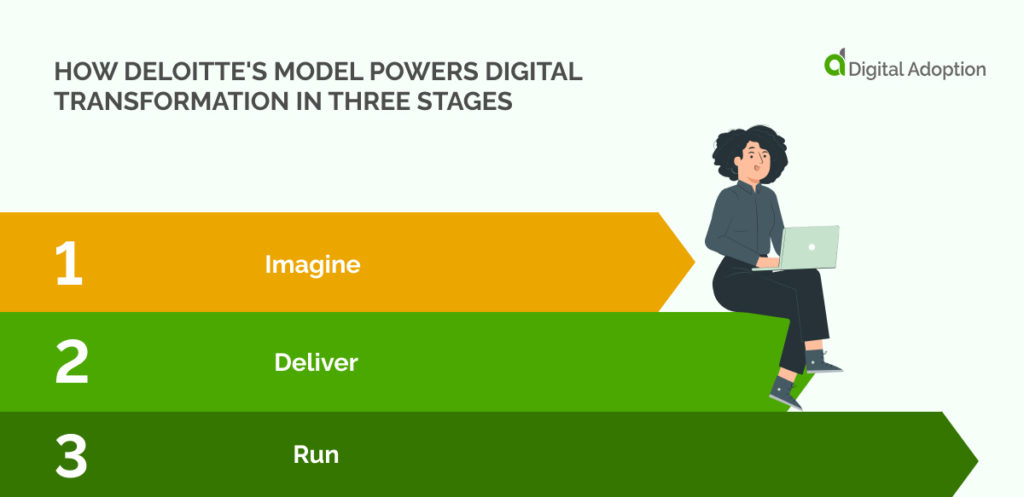
As this article discussed, Deloitte’s Digital Maturity Model (DMM) is a powerful tool for supporting digital transformation projects at all process stages. The model helps organizations evaluate their current digital maturity level and design interventions to elevate their entire system.
Deloitte’s approach goes beyond measuring digital maturity, as it provides guidance on how the DMM can be used in conjunction with a full digital transformation (DX) project. The tool’s power for digital transformation is an important part of their documentation, which runs through three stages.
By using the DMM in this way, Deloitte’s model helps organizations achieve a high digital maturity level, turning that into a successful digital transformation that drives business value.
- Imagine
First, the DMM tool can be used at the planning stage, where organizations can engage in blue-sky thinking. DMM can evaluate its current strengths and weaknesses and show the project team where interventions should be focused to achieve the best possible outcomes. The DMM makes sure that planning does not take a “scattergun” approach but that the big ideas for digital technologies can be implemented strategically.
- Deliver
Next, the organization takes the ideas and data into actionable plans. The DMM is then used again to project how the delivery of the DX project will change things. The “deliver” stage will involve a clear review of the existing maturity benchmarks, in which they can lay out the success criteria for the digital transformation efforts.
- Run
At the final stage, the organization implements the proposed changes, and begins to see the benefits and problems of the solution. At this stage, the change management team can undertake a final measurement of digital maturity benchmarks. With clear records of digital progress, the organization can gauge the project’s business value and plan for further digital changes in the future.
Types of Digital Maturity Models
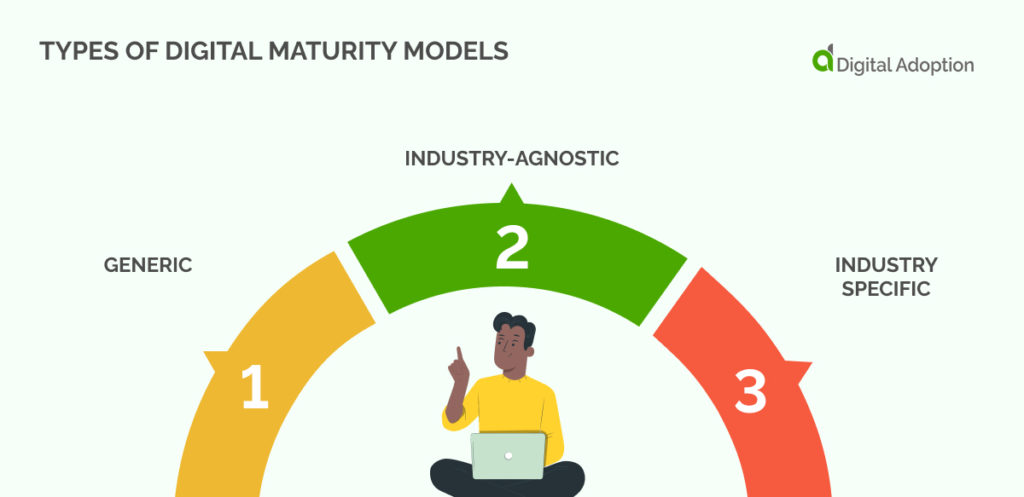
Choosing the right digital maturity model is essential to get a clear and balanced view of an organization’s technological status. And it is not always obvious which will be the most helpful.
After all, there is a big range of approaches. On the one hand, the Google / BGC approach could be applied to almost any size business.
But some models have far more limited applications. One example is the 2022 Digital Transformation Maturity Model published in the OECD Tax Administration Maturity Model Series. It’s a great model for national tax administration systems – but not so good for anything else.
Leading IT consultant Dave Rutkowski defines digital maturity models in three categories: generic, industry-agnostic, and industry-specific.
- Generic
A generic digital maturity model is a simple framework judged on a scale from basic to advanced stages of digital skills and knowledge. This model looks at how well an organization can leverage technology to improve operations, optimize processes, and create value for customers. Generic models can be applied to almost any industry, but as a result, they may lose out on some of the specific details in a complex organization.
- Industry-Agnostic
An industry-agnostic digital maturity model is a more robust and refined version of the generic digital maturity model. This model considers multiple aspects of an organization, such as its strategy, operations, people, processes, and technology. Industry-agnostic models may start to give a clearer view of how companies can increase digital maturity for a specific type of business structure.
- Industry Specific
An industry-specific digital maturity model considers the individual nuances and contexts within an industry. This model looks at the unique characteristics of a particular industry and how digital technologies can be used to address those challenges. This model is the most tailored version of the digital maturity models, allowing organizations to understand their industry’s specific needs and opportunities to make smarter business decisions.
The Six Top digital maturity challenges
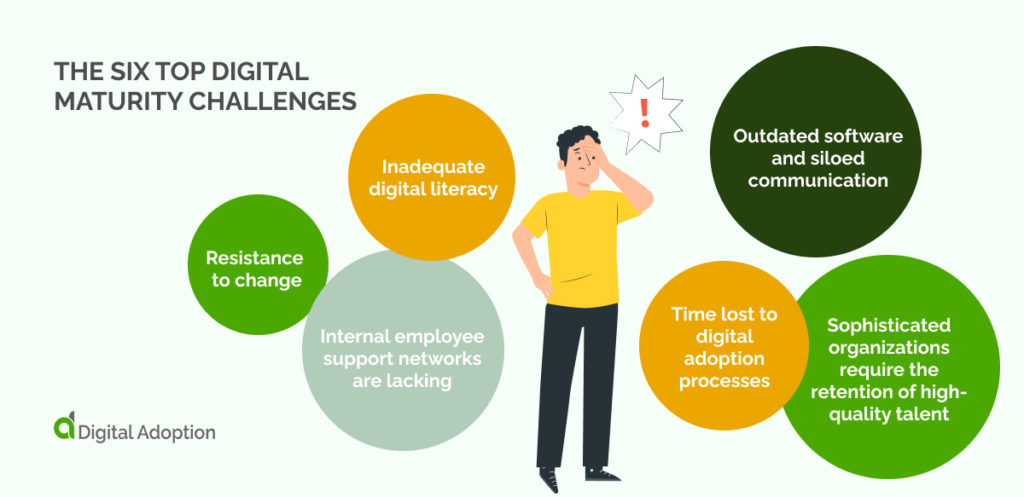
Achieving a high level of digital maturity is essential for businesses looking to stay competitive in today’s fast-paced, technology-driven world. However, achieving digital maturity can be challenging, and there are several challenges that organizations must overcome to succeed. This section will explore six top digital maturity challenges businesses may face. Understanding and addressing these challenges is crucial for businesses looking to achieve optimal digital maturity in the long term.
Resistance to change
Internal organizational resistance is the biggest challenge to a high level of digital maturity. If the technology works perfectly, but the staff doesn’t want to embrace new digital growth, the company will not produce the full value of its investments.
Inadequate digital literacy
The workforce of today has more technology at their fingertips than ever before. However, they may still prefer traditional methods for their work. In these cases, they need a higher level of digital literacy, making new demands to learn, adapt, and apply their knowledge.
Internal employee support networks are lacking
Often, digital transformation initiatives fail because the staff hasn’t had sufficient training and support. Achieving a high level of digital maturity depends on the organization’s ability to nurture support networks and training opportunities.
Outdated software and siloed communication
A company’s digital maturity will often suffer from poor communication between business units, leading to compatibility problems between software packages. For the overarching digital changes, different parts of the company will use vastly different types of software. This separation becomes a problem when a company tries to link all its software. Digitally mature organizations understand that cross-department communications are essential to creating digital solutions that work efficiently for the whole company.
Time lost to digital adoption processes
Digital adoption takes time and effort.
Optimal digital maturity in the long term always requires the investment of staff time in the short term. Companies planning these strategies carefully can achieve business value from digital maturity in the long run.
Sophisticated organizations require the retention of high-quality talent
A very good change manager must understand the latest disruptive technological trends. And it takes an experienced employee to understand the specific problems for applying digital initiatives in a particular company.
Other companies can easily poach the best talent once the immediate implementation of a change project has been achieved. Attentive C-suite leaders should be aware of this possibility and offer appropriate incentives to keep a hold on the best staff.
The role of digital adoption in achieving digital maturity
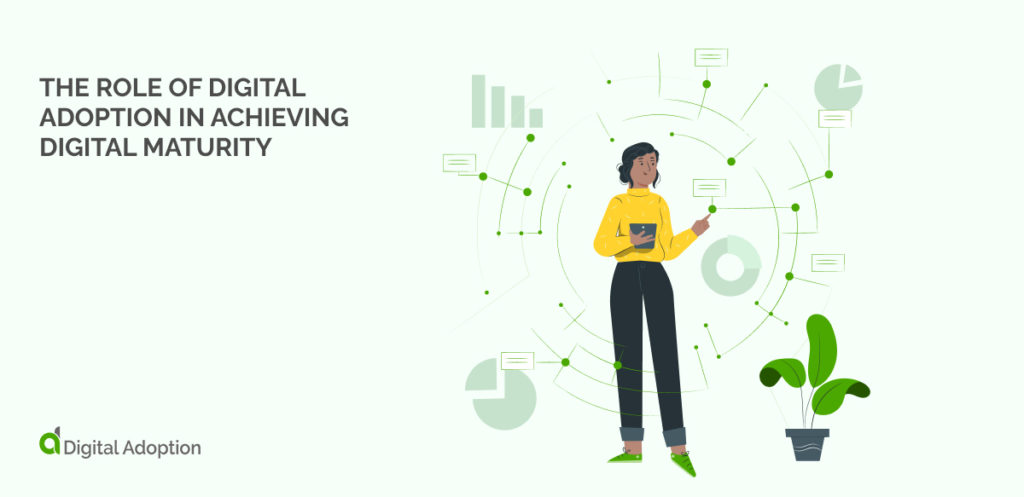
The process of digital adoption is a crucial part of digital transformation. In rare cases, staff instinctively improve their ability to employ new digital technologies. More commonly, companies need to support and encourage digital adoption to achieve higher digital maturity overall. Four ways to improve digital adoption include DAPS, In-App training, Guided workflow, and interactive workflows.
Digital adoption platforms (DAPs)
To create an accurate picture of digital maturity, analysis requires much information about how users engage with software. Using a digital adoption platform is one fantastic way to observe user behavior from a distance. The information they create around digital adoption practices feeds directly into digital maturity data.
In-app training
By providing training directly within the app or software that employees are using, organizations can ensure that employees can learn at their own pace and in a way that is directly relevant to their work. This can be particularly useful for organizations undergoing a digital transformation. It allows employees to learn and adapt to new technologies and processes in real time without additional training sessions or materials.
Guided workflows
Guided workflows can help digital adoption by providing employees with step-by-step instructions for completing tasks using new technologies or software. By providing clear and concise guidance for completing tasks, organizations can help employees become more efficient and productive, which can increase digital maturity. In addition, guided workflows can help to reduce errors and improve the overall quality of work, which can further contribute to a company’s digital maturity. By using guided workflows, organizations can support digital adoption and help their employees reach a higher level of digital maturity.
Interactive walkthroughs
Interactive walkthroughs can help digital adoption by providing employees with a more engaging and immersive way to learn new technologies and processes. By using interactive elements such as videos, animations, and quizzes, organizations can make learning more interactive and interactive, which can help to increase employee engagement and retention. This strategy helps employees quickly reach a higher level of digital maturity.
Why mature digital capabilities are key for value creation
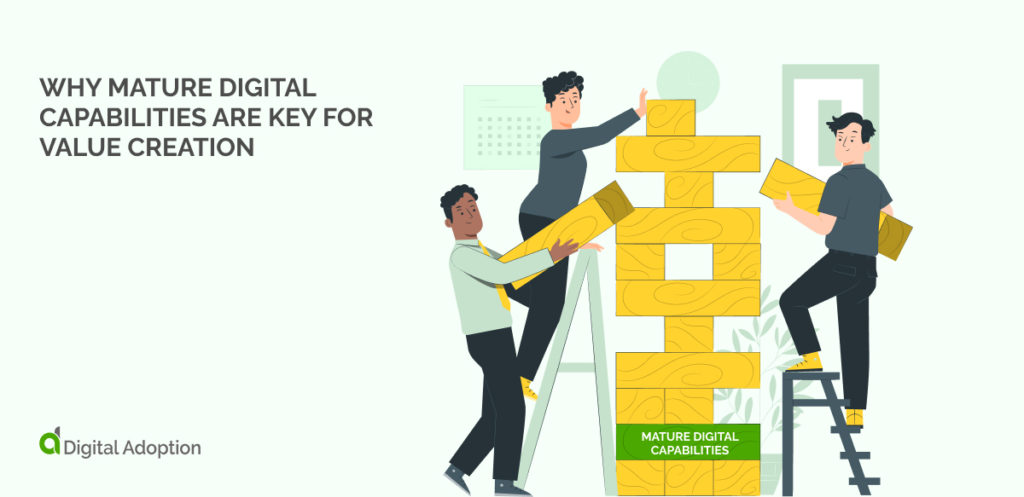
Good digital capabilities are essential for creating business value in today’s fast-paced, technology-driven world. By investing in the right technologies and building a strong foundation of digital skills and knowledge, organizations can improve operational efficiency, enhance customer experience, and drive innovation.
By investing in digital capabilities, organizations can create value through improved efficiency, enhanced customer experiences, and innovative products and services. The bottom line is that businesses need to invest in digital technologies and training programs to remain competitive and succeed in this increasingly digitized world.
Creating a digitally mature organization and beyond
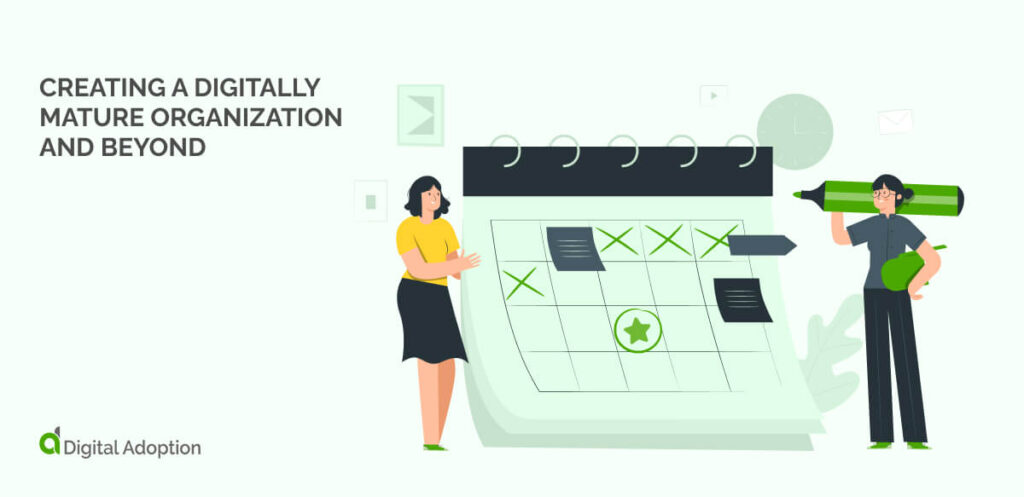
A digital maturity model is just one of the many tools a digital transformation project needs to help achieve business outcomes. Indeed, with a good idea of digital maturity, businesses can orchestrate their digital transformation strategies precisely.
Some companies will only take on digital strategies when they have to: in such cases, they will wish they embraced digital transformation sooner. Indeed, digital maturity is essential for businesses that plan to succeed in today’s digital-first world.
Organizations need to invest in the right technologies, embrace a culture of digital adoption, and provide training programs for employees to ensure they have the necessary skills and knowledge to use these new technologies effectively. By doing this, organizations can create value through improved efficiency, enhanced customer experiences, and innovative products and services.
With the right digital maturity model in place, organizations can ensure their digital transformation projects will succeed for years.

